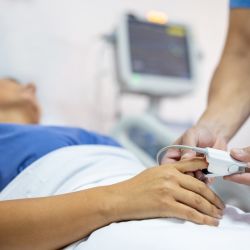Sleep measurement in critically ill patients remains a barrier for large studies on ICU sleep and circadian disruption (SCD). The gold standard, polysomnography, is difficult to interpret due to factors like medications and complex illnesses. While portable, wearable devices have improved sleep and circadian function measures, challenges persist for bedside utility, including cost, feasibility, tolerance, and interpretability for continuous monitoring without affecting patient care. Advances in these areas could enhance meaningful ICU SCD definitions, guide intervention timing, and support rigorous outcome evaluation.
In a recent study, researchers used the automated electroencephalography odds ratio product (ORP) to measure 10 different deciles of stages of alertness from deep sleep to full wakefulness and spindle density over time. Despite criticisms for limited accuracy in identifying sleep stages, the ORP appears to be a feasible and tolerable measure for longitudinal monitoring. The study used a dataset from a multicenter longitudinal cohort from the National Heart, Lung and Blood Institute, comparing the frequency of common ORP types associated with clinical phenotypes.
The study reveals a significant difference between sleep patterns in ICU patients and community-dwelling adults. ICU patients exhibited four ORP types: low depth of sleep and variable (low to high) full wakefulness (types 1,1, 1,2, and 1,3 or average sleep depth with little time spent tin full wakefulness. In contrast, community-dwelling adults commonly displayed ORP patterns with high sleep depth and variable levels of full wakefulness (types 3,1; 3,2; and 3,3) and average sleep depth with moderate or high full wakefulness (types 2,2 and 2,3). Clinical phenotypes commonly seen in ICU patients, such as type 1,1, resemble those in community-dwelling adults with severe obstructive sleep apnoea. Type 1,3, common in ICU patients, is similar to community-dwelling adults with insomnia experiencing low sleep pressure. The study also suggests limited time needed for sleep in ICU survivors, with little deep sleep continuing to dominate over time.
The findings of the study confirm existing knowledge about common sleep disturbances in critically ill patients and provide evidence for different sleep patterns (phenotypes). However, there are significant methodological limitations to consider.
Understanding the complex relationship between sleep in the ICU, survivors' sleep and post-ICU syndrome requires causal inference models from diverse critically ill populations with sequential measurements. Many causal assumptions remain unclear, such as whether poor sleep in the ICU causes short-term complications or contributes to post-intensive care syndrome. The study highlights the need for more research on a broader population of critically ill patients to unravel the intricate pathways and causal effects of poor sleep on outcomes in the ICU.
Source: Annals ATS
Image Credit: iStock

























